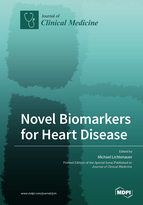Novel Biomarkers for Heart Disease
A special issue of Journal of Clinical Medicine (ISSN 2077-0383). This special issue belongs to the section "Cardiology".
Deadline for manuscript submissions: closed (29 February 2020) | Viewed by 103051
Special Issue Editor
Interests: biomarkers; myocardial ischemia; heart failure; HFpEF; microRNA; vascular/endothelial stress; atherosclerosis; valvular heart disease; risk assessment; mortality prediction
Special Issues, Collections and Topics in MDPI journals
Special Issue Information
Dear Colleagues,
Cardiac biomarkers such as troponins and natiuretic peptides have made a great impact on clinical decision making as well as improving our understanding of molecular mechanisms of different disease conditions. However, the biomarkers that are currently in use do not reflect all the multiple disease pathways that are involved in a broad spectrum of cardiac disease conditions ranging from acute coronary syndrome, to heart failure (and heart failure with preserved ejection fraction, HFpEF), to pulmonary hypertension or arrhythmias. In this Special Issue, we will provide an overview of the current developments in the field of biomarker research, beginning with research on molecular pathways and cellular communication (e.g., microRNA) up to the clinical use of biomarkers.
Dr. Michael Lichtenauer
Guest Editor
Manuscript Submission Information
Manuscripts should be submitted online at www.mdpi.com by registering and logging in to this website. Once you are registered, click here to go to the submission form. Manuscripts can be submitted until the deadline. All submissions that pass pre-check are peer-reviewed. Accepted papers will be published continuously in the journal (as soon as accepted) and will be listed together on the special issue website. Research articles, review articles as well as short communications are invited. For planned papers, a title and short abstract (about 100 words) can be sent to the Editorial Office for announcement on this website.
Submitted manuscripts should not have been published previously, nor be under consideration for publication elsewhere (except conference proceedings papers). All manuscripts are thoroughly refereed through a single-blind peer-review process. A guide for authors and other relevant information for submission of manuscripts is available on the Instructions for Authors page. Journal of Clinical Medicine is an international peer-reviewed open access semimonthly journal published by MDPI.
Please visit the Instructions for Authors page before submitting a manuscript. The Article Processing Charge (APC) for publication in this open access journal is 2600 CHF (Swiss Francs). Submitted papers should be well formatted and use good English. Authors may use MDPI's English editing service prior to publication or during author revisions.
Keywords
- Heart disease
- Heart failure
- Myocardial infarction
- Biomarkers
- Outcome
- Biomarker guided therapy
- Biomarker development and validation







